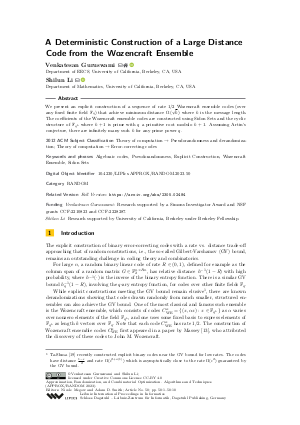A Deterministic Construction of a Large Distance Code from the Wozencraft Ensemble
Authors
Venkatesan Guruswami  ,
Shilun Li
,
Shilun Li 
-
Part of:
Volume:
Approximation, Randomization, and Combinatorial Optimization. Algorithms and Techniques (APPROX/RANDOM 2023)
Part of: Series: Leibniz International Proceedings in Informatics (LIPIcs)
Part of: Conference: International Conference on Approximation Algorithms for Combinatorial Optimization Problems (APPROX)
Part of: Conference: International Conference on Randomization and Computation (RANDOM) - License:
 Creative Commons Attribution 4.0 International license
Creative Commons Attribution 4.0 International license
- Publication Date: 2023-09-04
File

PDF
LIPIcs.APPROX-RANDOM.2023.50.pdf
- Filesize: 0.7 MB
- 10 pages
Document Identifiers
Related Versions
- Full Version https://arxiv.org/abs/2305.02484
Subject Classification
ACM Subject Classification
- Theory of computation → Pseudorandomness and derandomization
- Theory of computation → Error-correcting codes
Keywords
- Algebraic codes
- Pseudorandomness
- Explicit Construction
- Wozencraft Ensemble
- Sidon Sets
Metrics
- Access Statistics
-
Total Accesses (updated on a weekly basis)
0PDF Downloads0Metadata Views
Abstract
We present an explicit construction of a sequence of rate 1/2 Wozencraft ensemble codes (over any fixed finite field 𝔽_q) that achieve minimum distance Ω(√k) where k is the message length. The coefficients of the Wozencraft ensemble codes are constructed using Sidon Sets and the cyclic structure of 𝔽_{q^k} where k+1 is prime with q a primitive root modulo k+1. Assuming Artin’s conjecture, there are infinitely many such k for any prime power q.
Cite As Get BibTex
Venkatesan Guruswami and Shilun Li. A Deterministic Construction of a Large Distance Code from the Wozencraft Ensemble. In Approximation, Randomization, and Combinatorial Optimization. Algorithms and Techniques (APPROX/RANDOM 2023). Leibniz International Proceedings in Informatics (LIPIcs), Volume 275, pp. 50:1-50:10, Schloss Dagstuhl – Leibniz-Zentrum für Informatik (2023)
https://doi.org/10.4230/LIPIcs.APPROX/RANDOM.2023.50
BibTex
@InProceedings{guruswami_et_al:LIPIcs.APPROX/RANDOM.2023.50,
author = {Guruswami, Venkatesan and Li, Shilun},
title = {{A Deterministic Construction of a Large Distance Code from the Wozencraft Ensemble}},
booktitle = {Approximation, Randomization, and Combinatorial Optimization. Algorithms and Techniques (APPROX/RANDOM 2023)},
pages = {50:1--50:10},
series = {Leibniz International Proceedings in Informatics (LIPIcs)},
ISBN = {978-3-95977-296-9},
ISSN = {1868-8969},
year = {2023},
volume = {275},
editor = {Megow, Nicole and Smith, Adam},
publisher = {Schloss Dagstuhl -- Leibniz-Zentrum f{\"u}r Informatik},
address = {Dagstuhl, Germany},
URL = {https://drops.dagstuhl.de/entities/document/10.4230/LIPIcs.APPROX/RANDOM.2023.50},
URN = {urn:nbn:de:0030-drops-188751},
doi = {10.4230/LIPIcs.APPROX/RANDOM.2023.50},
annote = {Keywords: Algebraic codes, Pseudorandomness, Explicit Construction, Wozencraft Ensemble, Sidon Sets}
}
Author Details
Funding
- Guruswami, Venkatesan: Research supported by a Simons Investigator Award and NSF grants CCF-2210823 and CCF-2228287.
- Li, Shilun: Research supported by University of California, Berkeley under Berkeley Fellowship.
References
-
Wallace C Babcock. Intermodulation interference in radio systems frequency of occurrence and control by channel selection. The Bell System Technical Journal, 32(1):63-73, 1953.

-
Roger C Baker, Glyn Harman, and János Pintz. The difference between consecutive primes, ii. Proceedings of the London Mathematical Society, 83(3):532-562, 2001.

- R. C. Bose. An affine analogue of singer’s theorem. The Journal of the Indian Mathematical Society, 6(0), 1942. URL: https://www.i-scholar.in/index.php/JIMSIMS/article/view/151305.
-
Raj Chandra Bose and Sarvadaman Chowla. Theorems in the additive theory of numbers. Technical report, North Carolina State University. Dept. of Statistics, 1960.

-
Pafnutij Lvovič Čebyšev. Mémoire sur les nombres premiers, 1850.

-
Apostolos Dimitromanolakis. Analysis of the golomb ruler and the sidon set problems and determination of large near-optimal golomb rulers. Diploma thesis, Department of Electronic and Computer Engineering, Technical University of Crete, 2002.

-
Paul Erdos and Pál Turán. On a problem of sidon in additive number theory, and on some related problems. J. London Math. Soc, 16(4):212-215, 1941.

-
Philippe Gaborit and Gilles Zemor. Asymptotic improvement of the gilbert-varshamov bound for linear codes. IEEE Transactions on Information Theory, 54(9):3865-3872, 2008.

-
Tao Jiang and Alexander Vardy. Asymptotic improvement of the Gilbert-Varshamov bound on the size of binary codes. IEEE Trans. Inf. Theory, 50(8):1655-1664, 2004.

-
Jørn Justesen. Class of constructive asymptotically good algebraic codes. IEEE Transactions on Information Theory, 18(5):652-656, 1972.

-
Bernt Lindström. On b2-sequences of vectors. Journal of number Theory, 4(3):261-265, 1972.

- Dick Lipton. An error correcting code from the book. https://rjlipton.wpcomstaging.com/2011/08/08/an-error-correcting-code-from-the-book/, August 2011.
-
James L Massey. Threshold decoding, 1963.

-
Aditya Potukuchi and Yihan Zhang. Improved efficiency for covering codes matching the sphere-covering bound. In 2020 IEEE International Symposium on Information Theory (ISIT), pages 102-107. IEEE, 2020.

-
B-Z Shen. A justesen construction of binary concatenated codes that asymptotically meet the zyablov bound for low rate. IEEE Transactions on Information Theory, 39(1):239-242, 1993.

-
Amir Shpilka. Capacity achieving two-write wom codes. In Latin American Symposium on Theoretical Informatics, pages 631-642. Springer, 2012.

-
Amir Shpilka. New constructions of wom codes using the wozencraft ensemble. IEEE Transactions on Information Theory, 59(7):4520-4529, 2013.

-
Simon Sidon. Ein satz über trigonometrische polynome und seine anwendung in der theorie der fourier-reihen. Mathematische Annalen, 106(1):536-539, 1932.

-
Amnon Ta-Shma. Explicit, almost optimal, epsilon-balanced codes. In Proceedings of the 49th Annual ACM SIGACT Symposium on Theory of Computing, pages 238-251, 2017.

- E.J. Weldon. Justesen’s construction-the low-rate case (corresp.). IEEE Transactions on Information Theory, 19(5):711-713, 1973. URL: https://doi.org/10.1109/TIT.1973.1055068.
